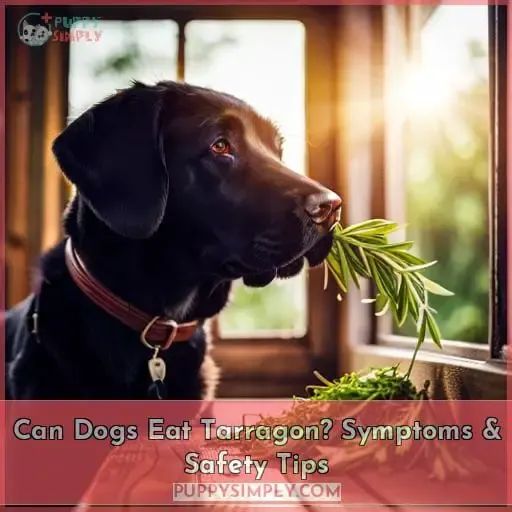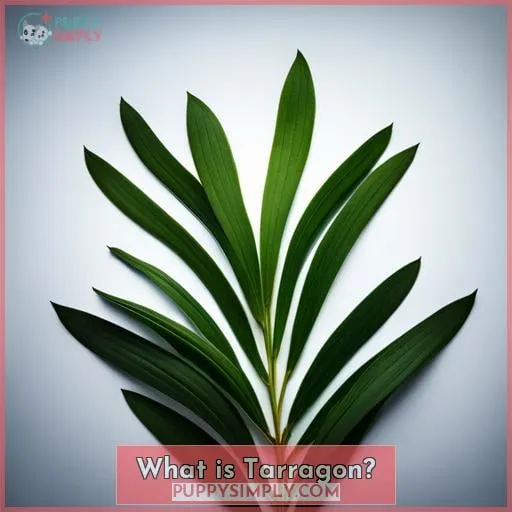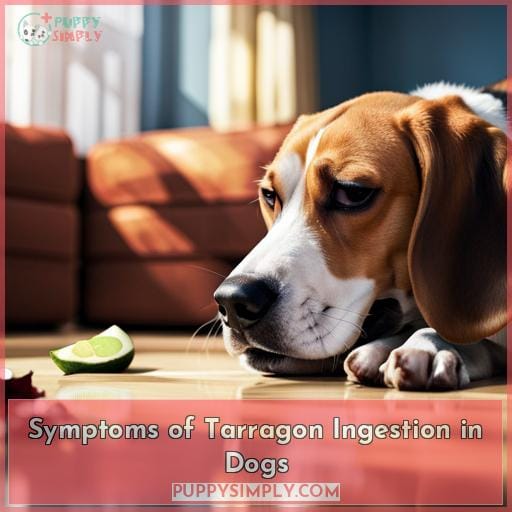This site is supported by our readers. We may earn a commission, at no cost to you, if you purchase through links.
 As you might imagine, pet owners often ask themselves if their furry friends can safely eat the same things they do.
As you might imagine, pet owners often ask themselves if their furry friends can safely eat the same things they do.
The short answer is a resounding no. According to research from the ASPCA, tarragon and other herbs like pennyroyal (Mentha pulegium), tea tree oil (Melaleuca alternifolia), comfrey (Symphytum officinale), white willow bark (Salix alba), and Ma Huang (Ephedra sinica) are toxic to dogs when ingested in large enough quantities.
In fact, it’s not just these culinary herbs either – any plant that contains essential oils or saponins should be avoided by your pup as they may cause vomiting or diarrhea if eaten in large enough amounts.
So what symptoms should you look out for if your dog has somehow got hold of some tarragon? While every dog reacts differently depending on how much was consumed, common signs include lethargy and loss of appetite – so keep an eye out for any changes in behavior after eating something unusual!
Table Of Contents
Key Takeaways
- Tarragon is toxic for dogs, and even small amounts can be dangerous.
- If tarragon is ingested, it is important to contact a vet or poison control immediately.
- Signs of tarragon toxicity include drooling, vomiting, diarrhea, unsteadiness, seizures, and coma.
- Preventive measures should be taken to keep tarragon away from pets and inform other owners about the toxicity risks.
Why is Tarragon Bad for Dogs?
You’re probably aware that tarragon can be dangerous for your beloved pet, as it is known to contain toxic essential oils which can cause mild vomiting and diarrhea. It’s important to keep an eye on what your canine companion is eating in order to prevent any potential digestion issues stemming from consuming the herb.
Tarragon belongs to a list of common pet poisons, so its toxicity levels should not be taken lightly. While herbal remedies such as white willow bark or garlic have been used successfully by some owners with pets suffering from minor ailments, tea tree oil, comfrey, and wormwood are all considered unsafe for dogs due to their high concentrations of toxins when ingested orally.
If you suspect that your pup has eaten tarragon recently, then contact a vet immediately; even if they don’t seem unwell now, there may still be risks associated with continued consumption over time.
What Should I Do if My Dog Eats Tarragon?
If your pet has consumed tarragon, act quickly to help protect them from its toxicity. Tarragon is toxic for dogs, cats, and horses due to the essential oils it contains, which can cause mild vomiting or diarrhea when ingested.
If you suspect that your pet has eaten any of this plant, contact a vet or an animal poison control center immediately – their phone number is (888) 426-4435.
It’s also important to remove all remaining tarragon during food prep to prevent access by pets. Symptoms indicate that tarragon’s essential oils are what make it toxic for animals. Drooling signifies mouth/throat irritation, while vomiting and diarrhea point to gastrointestinal upset.
Unsteadiness reflects central nervous system depression, while seizures and coma are concerning signs of large exposures.
In order to treat ingestion cases successfully, take away any remaining pieces of the plant if you catch your dog eating some. Then watch out for common symptoms like vomiting, drooling, or uncoordination before calling up a vet right away.
The vet will determine if emergency care is needed depending on how much was consumed. Small amounts usually respond well, but larger doses may require hospitalization.
Moreover, prevention strategies such as keeping fresh/dried plants away from animals should always be followed. Monitoring our furry friends constantly when they have access near these types of plants will minimize risks associated with potential toxicity issues.
In addition, sharing information regarding this type of plant toxicity among fellow owners helps us stay vigilant about our beloved four-legged family members’ safety around potentially dangerous substances like French Tarragon (aka Estragom).
For more details on why certain plants could pose danger for our canine companions, check out online toxic galleries list!
What is Tarragon?
If you’ve ever found your pet chowing down on a sprig of tarragon, you may be wondering if it’s safe for them to eat. Tarragon is an herb that can be toxic to certain animals, including dogs and cats. It contains essential oils that can cause mild vomiting and diarrhea in pets if ingested.
To ensure the safety of your furry friend, it’s important to monitor their access to this plant and take quick action if they consume any amount of tarragon or other potentially harmful herbs. Your vet should always be consulted when dealing with potential pet poisoning from plants like tarragon, as each situation requires its own approach depending on how much was eaten by the animal in question.
In some cases where small amounts were consumed, simply monitoring the animal’s condition will suffice. However, larger quantities may require emergency care at an animal hospital for further treatment if necessary.
In addition to keeping these items away from curious canine mouths, owners must also inform themselves about other common household hazards, such as chocolate or tea tree oil.
Taking steps towards educating yourself about food safety precautions is key when caring for pets who depend solely upon us humans for their well-being!
Tarragon & Dogs
It’s important to remember that tarragon is toxic to your furry friend, so keeping it away from them is essential. If ingested, symptoms may include vomiting and diarrhea in dogs, as well as low body temperature and low blood pressure.
Here are four key points regarding tarragon toxicity:
- Tarragon contains essential oils that can be poisonous for pets.
- Symptoms of poisoning can range from mild gastrointestinal upset to more serious effects, such as seizures or coma.
- Contact a vet immediately if ingestion is suspected.
- Monitor your pet closely when potentially toxic substances are available.
Treatment will depend on the amount eaten by the dog. Smaller exposures often require only monitoring, while larger amounts may need emergency care. Hospitalization may be necessary in some cases due to ma huang toxicity, which has similar side-effects, including cardiac issues like arrhythmias among others.
It’s also important for pet owners to take preventive measures, such as keeping fresh and dried plants out of reach of all animals at home, so they don’t accidentally access them, resulting in potential harm.
Symptoms of Tarragon Ingestion in Dogs
Step right up and learn about the potential dangers of a few common plants that can be toxic to dogs. Pennyroyal (Mentha pulegium), Tea Tree Oil (Melaleuca alternifolia), Comfrey (Symphytum officinale), White Willow Bark (Salix alba), and Ma Huang (Ephedra sinica) are all known for their toxicity in dogs.
With just a bit of knowledge, you can help protect your pup from harm by avoiding these substances or being able to recognize any signs of ingestion if they do occur.
Pennyroyal (Mentha Pulegium)
Pennyroyal (Mentha pulegium) is an aromatic herb that can be toxic to dogs, causing severe gastrointestinal upset and even central nervous system depression. Herbal remedies should always be used with caution, as plant toxicity can lead to pet risks, such as side effects including dilated pupils.
Yucca should also not be given to pets – and neither should tarragon! It’s important for owners to stay informed about what their animals consume in order to ensure safety and prevent any adverse reactions.
Tea Tree Oil (Melaleuca Alternifolia)
You should always be aware of tea tree oil toxicity in dogs, as it can cause skin irritation and allergic reactions. Dangers include poisoning if ingested or inhaled, with side effects ranging from mild to severe depending on the dosage.
Treatment ranges from topical ointments to vet-administered fluids and medications for more serious cases.
Comfrey (Symphytum Officinale)
Comfrey, also known as Symphytum officinale, is a herb that can be dangerous if ingested by dogs; it’s like an invisible enemy waiting to strike. Its uses range from herbal remedies to dietary supplements and even foraging dangers.
Plant toxicity should always be taken into consideration before using this medicinal herb since it can cause serious adverse reactions in animals.
Here are five key points about comfrey:
- It has many beneficial therapeutic properties when used correctly.
- It can cause gastrointestinal distress if consumed by pets.
- It should never be given as food or treats without proper advice from a vet.
- It is not recommended for internal use due to potential liver damage.
- Always consult with your veterinarian prior to giving any herbal remedy or supplement.
Be mindful of the risks associated with comfrey and other plant-based medicines so you don’t unknowingly put your pet in danger!
White Willow Bark (Salix Alba)
White willow bark contains salicin, which can be toxic to dogs if ingested. Take caution when it is around your pup as poisoning symptoms may occur with even small amounts. Safe dosage is key for medicinal uses and herbal remedies, so consult a vet before use or keep away from Fido altogether.
Ma Huang (Ephedra Sinica)
Ma Huang, also known as Chinese Ephedra, has been used for centuries as a stimulant and decongestant – like an energy drink for your body. It’s important to be aware of herb safety when dealing with dogs; this one is no exception since it can cause toxicity if ingested.
Pet medications or probiotics may help manage any symptoms while a bland diet is recommended in the case of larger quantities consumed. Seek medical advice immediately if you suspect ingestion and follow symptom management guidance from a vet carefully.
Are Culinary Herbs Safe for Dogs?
Many culinary herbs are unsafe for your pet, so it’s important to be aware of the potential risks before feeding them any type of herb. Tarragon is one example, as its essential oils can cause mild vomiting and diarrhea in dogs.
Eating tarragon can also lead to drooling, which indicates mouth or throat irritation from these toxic compounds. Ingestion may even lead to uncoordination due to central nervous system depression from exposure.
In more serious cases, seizures or coma may occur if a large enough amount has been consumed. It’s best practice, then, when preparing food with tarragon, to remove all traces before allowing pets access, as they won’t understand the consequences associated with eating this plant species either in its fresh or dried form within their diet requirements.
It’s not just limited to tarragon’s toxicity, but there also exist potentially cancerous effects linked to other plants such as poisonous nightshades like potatoes and tomatoes, as well as herbal remedies derived from sage, rosemary, etc.
So it’s critical that we take special care when cooking around our furry friends, understanding what ingredients might negatively affect them. This understanding should be based on the dietary restrictions provided on clinical advice given by vets beforehand.
Overall, many common kitchen herbs have hazardous properties towards canine health. Therefore, knowledge must be taken seriously alongside preventative measures implemented throughout the homely environment when dealing with food preparation containing known poisonous substances alike.
Frequently Asked Questions (FAQs)
How Much Tarragon is Toxic for Dogs?
Tarragon is toxic for dogs, with ingestion of even small amounts leading to vomiting and diarrhea. Large exposures can cause seizures and even coma. It’s important to be aware that just 2-3 inch branches of tarragon can lead to serious complications in larger breeds like 55 lb Howie.
How Long Does Tarragon Toxicity Last?
Tarragon toxicity can last up to 48 hours, so it is important to monitor your pet closely. In severe cases, hospitalization may be required. If ingestion is suspected, contact a vet or animal poison control immediately for guidance and treatment options.
What Are the Long-term Effects of Tarragon Toxicity?
Long-term effects of tarragon toxicity can include seizures, coma, or central nervous system depression. If ingestion is suspected, contact your vet immediately for advice and treatment.
Are There Any Natural Remedies for Tarragon Toxicity?
Natural remedies for tarragon toxicity are limited. If ingestion is suspected, contact your vet or animal poison control immediately. Drooling, vomiting, and diarrhea can be symptoms of essential oils being toxic to dogs.
To prevent toxicity, monitor access closely and take away any remaining tarragon if ingested.
Should I Take My Dog to the Vet After Eating Tarragon?
If your dog has eaten tarragon, contact your vet or animal poison control immediately. Symptoms such as vomiting and diarrhea could indicate poisoning, so taking prompt action is crucial to prevent more serious effects.
Conclusion
In summary, tarragon is a herb that can be toxic to dogs, but it isn’t always dangerous. While it can cause mild vomiting and diarrhea in dogs, it’s important to be aware of the potential risks of tarragon ingestion.
If you think your dog has eaten tarragon, contact your vet or animal poison control right away.
To keep your dog safe, remove tarragon during food prep and always monitor your pet closely when it has access to toxic substances. Remember, culinary herbs can be dangerous for dogs, so it’s important to share this information with others.
By being aware of the risks and taking the right steps when tarragon ingestion is suspected, you can help keep your pup safe.












